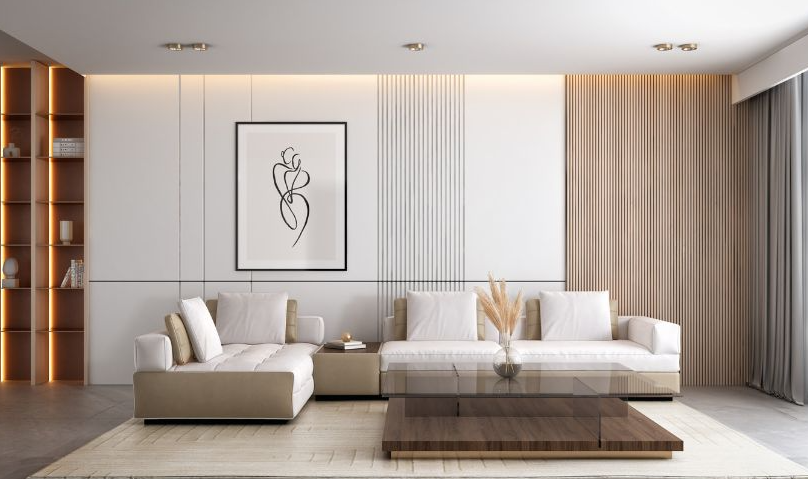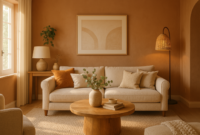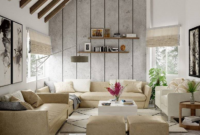Modern and Minimalist Living Room
In the ever-evolving world of interior design, the modern and minimalist living room has emerged as one of the most sought-after aesthetics for homeowners and designers alike. This design philosophy embodies simplicity, elegance, and functionality. At its core, it’s not just about having less—it’s about having the right elements that contribute to a sense of calm, clarity, and purpose.
This article delves deep into the concept of a modern and minimalist living room—what defines it, why it resonates with so many people, and how you can transform your space into a serene, stylish retreat that balances beauty with intentional living.
What is Modern Minimalism?
Modern minimalism blends two complementary styles: the clean lines and simplicity of minimalism with the elegance and functionality of modern design. It’s rooted in the idea that less is more—but with a contemporary twist. In a modern minimalist living room, everything has a place, and nothing is included without reason.
This style rejects clutter and unnecessary ornamentation. Instead, it embraces open spaces, natural light, muted tones, and functional furniture that fits seamlessly into the room. There’s a strong emphasis on form and function, and everything contributes to a calming, open atmosphere.
The Core Principles of a Modern and Minimalist Living Room
1. Simplicity and Functionality
Minimalist interiors strip away the unnecessary. Every item in the room should have a function, whether practical or aesthetic. Furniture is often multi-purpose—like a coffee table with hidden storage or a sofa that converts into a bed. The layout is clean and uncluttered, creating visual harmony.
2. Neutral Color Palette
Neutral tones dominate the modern minimalist living room. Whites, greys, beiges, and soft pastels form the foundational palette. These colors help create a tranquil atmosphere and act as a perfect backdrop for textures and natural materials like wood, leather, and metal.
3. Open Space and Light
One of the defining features of modern minimalism is the use of space. Open layouts, large windows, and natural light are critical. A minimalist space shouldn’t feel cramped or overdecorated—it should feel like it breathes.
4. Quality over Quantity
In minimalist design, less is truly more. It’s better to have fewer high-quality pieces than a room filled with decor. A beautifully crafted chair or a unique light fixture can be the focal point of the room.
5. Textural Contrast
Minimalist doesn’t mean sterile. A modern minimalist living room uses a variety of textures to add warmth and depth. Think soft wool rugs, smooth leather couches, raw wooden accents, or brushed metal details.
Essential Elements of a Modern and Minimalist Living Room
1. Furniture
Select furniture with clean lines and minimalist silhouettes. Low-profile sofas, streamlined chairs, and floating shelves are staples of this design. Avoid overly ornate or bulky furniture. Consider modular pieces that offer flexibility.
2. Lighting
Lighting plays a critical role in shaping the ambiance. Opt for floor lamps with slim, geometric designs or pendant lights with metallic finishes. Let in as much natural light as possible during the day by avoiding heavy curtains or blinds.
3. Wall Decor
Less is more when it comes to walls. One or two carefully chosen pieces of art or a large mirror can add character without overwhelming the space. Abstract art, line drawings, or black-and-white photography are popular choices.
4. Storage Solutions
A clutter-free room requires smart storage. Built-in shelving, under-sofa compartments, or minimalist cabinets can keep everyday items out of sight. The goal is to maintain visual cleanliness without sacrificing utility.
5. Plants and Natural Elements
While minimalist spaces are pared down, they’re not devoid of life. Incorporating greenery adds a touch of vitality and balances the neutral tones. Choose low-maintenance indoor plants like a fiddle-leaf fig, snake plant, or monstera.

Creating Your Own Modern Minimalist Living Room
Designing a minimalist space doesn’t mean buying all new furniture or getting rid of everything you own. It’s about curating your space intentionally. Here are step-by-step tips for creating your own:
1. Declutter Ruthlessly
Start by removing anything that doesn’t serve a purpose or bring joy. Books, decor, electronics, or furniture that adds visual noise can be put away or donated. Consider what you truly use and love.
2. Define a Neutral Base
Choose a cohesive color palette based on neutral tones. White or light gray walls make the perfect backdrop. From there, introduce soft earth tones or gentle accent colors for variety.
3. Choose Multi-Functional Pieces
Invest in furniture that works hard for your space. A minimalist coffee table with storage drawers or a wall-mounted media unit with hidden compartments keeps the space looking clean.
4. Add Personal Touches Sparingly
You don’t have to strip your personality from your home. Instead, incorporate meaningful objects—a family heirloom, a favorite book, a travel souvenir—in moderation. These pieces become more noticeable in a minimalist setting.
5. Let in the Light
Maximize natural light by using sheer curtains or none at all. If privacy is needed, choose light-filtering shades that still allow brightness into the room. Position mirrors to reflect sunlight and enhance the sense of openness.
Minimalism and Mental Well-being
Beyond aesthetics, a minimalist living room can significantly impact your mental and emotional well-being. Studies have shown that clutter increases stress and anxiety. In contrast, open, organized spaces promote calm, focus, and clarity.
When your living room is free from excess and filled only with things that serve a purpose or bring you peace, it becomes a sanctuary. Whether you’re unwinding after a long day or hosting a cozy gathering, your environment nurtures your sense of balance and ease.
Common Mistakes to Avoid
1. Over-minimizing
Sometimes, in pursuit of minimalism, people strip a space of too much—leaving it cold and uninviting. Don’t forget to add warmth through textures, soft lighting, and personal details.
2. Neglecting Storage
A minimalist space isn’t just about what’s on the surface. Proper storage is essential to maintain that clean look. Don’t rely solely on open shelves unless you’re good at keeping them tidy.
3. Choosing Style Over Comfort
Never sacrifice comfort for style. Minimalist furniture can still be cozy and inviting. Choose a soft, supportive couch or plush rugs that feel good underfoot.
Evolving with Time
Minimalism doesn’t have to be rigid or sterile. It should evolve with you. As your needs change, your space can adapt. Maybe you welcome a pop of color through a new chair, or you rearrange furniture to suit a new lifestyle. The beauty of minimalist design is its flexibility—it provides a foundation you can build upon or scale back as needed.
Final Thoughts
The modern and minimalist living room is more than a trend—it’s a lifestyle choice. It offers a chance to live intentionally, surrounded by beauty, simplicity, and clarity. It invites us to slow down, appreciate quality over quantity, and focus on what truly matters in our living space.
In a world that often feels chaotic and overwhelming, the calm, uncluttered atmosphere of a minimalist living room is a welcome refuge. Whether you’re just starting your design journey or refining your current space, the principles of modern minimalism can help you create a home that reflects both peace and purpose.


